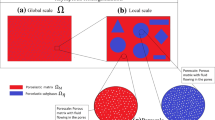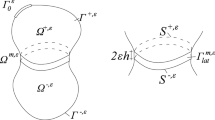Abstract
Poroelastic materials are widely used in many engineering applications. However, the problems of poroelasticity are usually complicated, and their analytical solutions are not often found. In this paper the semi-plane of poroelastic material is considered for the case when the boundary is loaded by mechanical load, and it is fully drained. The problem is formulated in a plane statement regarding two displacements of the solid skeleton and the pore pressure. The initial problem is reduced to a one-dimensional problem with the help of an infinite Fourier transform. The one-dimensional problem is formulated as a vector boundary-valued problem. The general solution of the vector homogeneous equation is constructed with the help of matrix differential calculation. According to it, the corresponding matrix equation is considered, and its fundamental solutions were derived. The vector of unknown constants is found for two subcases (when the integral transform parameter is greater than zero and when it is less than zero) from the boundary conditions. So, the analytical solution of the initial problem is derived. The displacements, stress and pressure inside the semi-plane are investigated. The cases of distributed and concentrated load are considered.
Access provided by Autonomous University of Puebla. Download conference paper PDF
Similar content being viewed by others
Keywords
1 Introduction
The mathematical modelling of poroelastic materials is a relevant problem in many areas of science and engineering, such as development of oil and gas fields and others. The theory of poroelasticity was developed by Terzaghi [1] for the one-dimensional case. The three-dimensional case and the generalization of the poroelasticity theory was done by Biot [2]. In [3] a formulation of Biot’s linear theory suitable for problems of soil mechanics was proposed. The equations of consolidation were reformulated in terms of undrained coefficients in [4].
The static contact problem about a rigid punch on the free surface of a linear porous elastic half-plane was solved with the use of a Fourier transform and a singular integral equation in [5]. The dynamic response of a poroelastic half-plane soil medium subjected to moving loads was studied analytically/numerically under conditions of plane strain in [6]. The loading function was presented there by a Fourier series expansion.
It is well known that the apparatus of mathematical physics’ boundary problems allows successful modeling of many complex dynamic problems of elasticity and destruction [7,8,9]. Authors of the present investigation set as their goal the application of the apparatus of generalized integral transforms and discontinuous problems to the solving of poroelasticity problems. With this aim the solving of the known model problem is proposed. It is derived by analytical transforms, and the exact formulae for the displacements, stress and pore pressure are found.
2 Statement of the Problem
The poroelastic semi-infinite plane \(y>0\) is considered. It’s boundary \(y=0\) is loaded by the load l(x), and perfect drainage conditions are fulfilled [10]:
Here p(x, y) is pore pressure, \(\sigma _y(x,y), \tau _{xy}(x,y)\) are normal and shear effective stresses.
The system of equilibrium and storage equations has the following form [11]
where \(u(x,y)=u_x(x,y), v(x,y)=u_y(x,y)\) are displacements of the solid skeleton, \(\kappa =3-4\mu \) is Muskhelishvili’s constant, \(\mu \) is Poisson ratio, G is shear modulus, \(\alpha \) is Biot’s coefficient, \(S_p\) is storativity of the pore space, k is permeability.
The stress state of the semi-plane, which satisfy (1)–(2) should be found.
3 One-Dimensional Problem
The initial problem (1)–(2) is reduced to the one-dimensional problem with the help of infinite Fourier transform applied with regard to variable x:
The one-dimensional problem in the transform space is formulated in vector form
Here \(L_2 \mathbf {y}_{\gamma }(y)=I \mathbf {y}_{\gamma }"-R\mathbf {y}_{\gamma }'+P\mathbf {y}_{\gamma }\), \(\mathbf {y}_{\gamma }=\left( \begin{array}{c} u_\gamma (y) \\ v_\gamma (y) \\ p_\gamma (y) \end{array}\right) \), I is identity matrix, \(R=\begin{pmatrix} 0 &{} \frac{2i\gamma }{\kappa -1} &{} 0 \\ \frac{2i\gamma }{\kappa +1} &{} 0 &{} \frac{\alpha }{G}\frac{\kappa -1}{\kappa +1} \\ 0 &{} \frac{\alpha }{k} &{} 0 \end{pmatrix}, P=\begin{pmatrix} -\gamma ^2 \frac{\kappa +1}{\kappa -1} &{} 0 &{} \frac{\alpha i\gamma }{G} \\ 0 &{} -\gamma ^2 \frac{\kappa -1}{\kappa +1} &{} 0 \\ \frac{\alpha i\gamma }{k} &{} 0 &{} -\gamma ^2 -\frac{S_p}{k} \end{pmatrix}\). The general solution of the homogeneous equation in (3) is constructed with the help of matrix differential calculation [12]. Accordingly to it the corresponding matrix equation is considered \(L_2 Y_{\gamma }=0\). The matrix \(Y_{\gamma }\) is chosen in the form \(Y_{\gamma }=e^{\eta y} I\) and substituted into the matrix equation. So, the equality \(L_2 e^{\eta y} I=M(\eta ) e^{\eta y}\) is derived, where \(M(\eta )=I\eta ^2-R\eta +P\).
The solution of the matrix homogeneous equation is constructed in the form [13]
here \(M^{-1}(\eta )\) is the inverse matrix to \(M(\eta )\).
The determinant of the matrix \(M(\eta )\) has four different roots \(\eta _{1,2}=\pm \gamma , \eta _{3,4}=\pm \sqrt{\gamma ^2 +\frac{S_p}{k} +\frac{\alpha ^2(\kappa -1)}{GK(\kappa +1)}}\), so there are derived four fundamental matrix solutions \(Y_i(y), i=\overline{1,4}\). The matrix solution \(Y_3(y)\) corresponding to the root \(\sqrt{\gamma ^2 +\frac{S_p}{k} +\frac{\alpha ^2(\kappa -1)}{GK(\kappa +1)}}\) is not considered, because the components of the matrix are increasing when \(y>0\).
The general solution of the problem (3) has the following form
Here \(Y^-(y)={\left\{ \begin{array}{ll} Y_1(y)+Y_4(y), \gamma <0, \\ Y_2(y)+Y_4(y), \gamma >0, \end{array}\right. }\) \(c_i, i=1,2,3\) are constants which are found for each form of \(Y^-(y)\) from boundary conditions in (3).
4 Analytical Solution
After inversion of the expression (4) the analytical solution of the initial problem (2) has the following form
Here \(c_{i,j}, i=1,2, j=1,2,3\) are constants found from boundary conditions in (3), index \(i=1\) corresponds to the case when \(\gamma <0\), and index \(i=2\) corresponds to the case when \(\gamma >0\).
5 Graphical Results and Discussion
The calculations were done for Ruhr sandstone [10], where \(G=1.33\cdot 10^{10}\,\mathrm{N/m}^2, \mu =0.12, \alpha =0.637, k=2\cdot 10^{-13}\,\mathrm{m}^4/\mathrm{N}\cdot s, S_p=3.9215\cdot 10^{-11}\,\mathrm{m}^2/\mathrm{N}\).
The case with concentrated load \(l(x)=\delta (X)\) is considered, and the results are presented on Figs. 1 and 2. As the load is symmetric, pore pressure and normal effective stress are symmetric. The biggest absolute values for these functions are reached when \(x=0\).
At the line \(y=1\) pore pressure (Fig. 1) is positive, decreasing to zero some way away from the point \(x=0\). This is caused by the drainage, which starts at the boundary of the semi-plane \(y=0\), and which produce a tendency for shrinkage of the semi-plane’s boundary. The effective stress \(\sigma _y(x,1)\) (Fig. 2) is negative, which is agreed with the compressive concentrated load. Stress’s \(\sigma _y(x,1)\) peak is at the point \(x=0\), where the load is applied. The case with distributed load \(l(x)={\left\{ \begin{array}{ll}1, -1<x<1 \\ 0, x\not \in [-1,1] \end{array}\right. }\) is considered. The results are shown in Figs. 3 and 4. The load is symmetric, so pore pressure and normal effective stress are symmetric. The biggest absolute values for these functions are reached when \(x=0\).
The pore pressure (Fig. 3) is positive at the line \(y=1\), decreasing to zero some way away from the point \(x=0\). The values of p(x, 1) for this load are bigger than for the case with the concentrated load. The values of effective stress \(\sigma _y(x,1)\) (Fig. 4) for this load are also bigger by absolute value than for the case with the concentrated load.
6 Conclusions
1. The analytical solution for poroelastic semi-plane is constructed with the help of the integral transform method and apparatus of matrix differential calculation.
2. Normal and shear effective stress, and pore pressure are investigated for different mechanical loads.
3. The comparison of the given problem results was done for the case when parameter \(\alpha =0\) with the given known solution for elastic half-space.
4. The proposed approach can be used for a more complicated shape of domains weakened by defects.
References
Terzaghi K (1925) Erdbaumechanik auf bodenphysikalischer Grundlage. Deuticke, Wien
Biot MA (1941) General theory of three-dimensional consolidation. J Appl Phys 12:155–164
Verruijt A (1969) Elastic storage of aquifers. In: R.D. Wiest (ed) Flow through porous media (1969)
Rice J, Cleary M (1976) Some basic stress diffusion solutions for fluid-saturated elastic porous media with compressible constituents. Rev Geophys Space Phys 14(2)
Scalia A, Sumbatyan MA (2000) Contact problem for porous elastic half-plane. J Elast 60:91–102
Theodorakopolous DD (2003) Dynamic analysis of a poroelastic half-plane soil medium under moving loads. Soil Dyn Earthq Eng 23:521–533
Kaplunov J, Prikazchikov DA, Rogerson GA (2005) On three-dimensional edge waves in semi-infinite isotropic plates subject to mixed face boundary conditions. J Acoust Soc Am 118(5). https://doi.org/10.1121/1.2062487
Zhbadynskyi Y, Mykhas’kiv VV (2018) Acoustic filtering properties of 3D elastic metamaterials structured by crack-like inclusions. In: 2018 XXIIIrd international seminar/workshop on direct and inverse problems of electromagnetic and acoustic wave theory (DIPED), pp 145–148. https://doi.org/10.1109/DIPED.2018.8543137
Hakobyan VN, Grigoryan AH (2021) Plane stress state of a uniformly piece-wise homogeneous plane with a periodic system of semi-infinite interphase cracks. Vestnik Samarskogo Gosudarstvennogo Tekhnicheskogo Universiteta, Seriya Fiziko-Matematicheskie Nauki 25(1):67–82
Cheng AH-D (2016) Poroelasticity. Theory and applications of transport in porous media, vol 27. Springer
Verruijt A (2010) An introduction to soil dynamics. Theory and applications of transport in porous media, vol 24. Springer (2010)
Vaysfel’d ND, Zhuravlova ZYu (2015) On one new approach to the solving of an elasticity mixed plane problem for the semi-strip. Acta Mech 226(12):4159–4172. https://doi.org/10.1007/s00707-015-1452-x
Popov GYa (2013) Exact solutions of some boundary problems of deformable solid mechanic (in Russian). Astroprint, Odessa
Author information
Authors and Affiliations
Corresponding author
Editor information
Editors and Affiliations
Rights and permissions
Copyright information
© 2022 The Author(s), under exclusive license to Springer Nature Singapore Pte Ltd.
About this paper
Cite this paper
Vaysfeld, N., Zhuravlova, Z. (2022). The Plane Problem of Poroelasticity for a Semi-plane. In: Abdel Wahab, M. (eds) Proceedings of the 4th International Conference on Numerical Modelling in Engineering. NME 2021. Lecture Notes in Mechanical Engineering. Springer, Singapore. https://doi.org/10.1007/978-981-16-8806-5_10
Download citation
DOI: https://doi.org/10.1007/978-981-16-8806-5_10
Published:
Publisher Name: Springer, Singapore
Print ISBN: 978-981-16-8805-8
Online ISBN: 978-981-16-8806-5
eBook Packages: EngineeringEngineering (R0)








